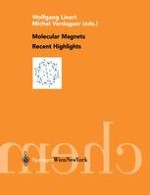2003 | OriginalPaper | Chapter
Magneto-Structural Correlations in Trinuclear Cu(II) Complexes: A Density Functional Study
Authors : Antonio Rodríguez-Fortea, Eliseo Ruiz, Pere Alemany, Santiago Alvarez
Published in: Molecular Magnets Recent Highlights
Publisher: Springer Vienna
Included in: Professional Book Archive
Activate our intelligent search to find suitable subject content or patents.
Select sections of text to find matching patents with Artificial Intelligence. powered by
Select sections of text to find additional relevant content using AI-assisted search. powered by
Density functional theoretical methods have been used to study magneto-structural correlations for linear trinuclear hydroxo-bridged copper(II) complexes. The nearest-neighbor exchange coupling constant shows very similar trends to those found earlier for dinuclear compounds for which the Cu-O-Cu angle and the out of plane displacement of the hydrogen atoms at the bridge are the two key structural factors that determine the nature of their magnetic behavior. Changes in these two parameters can induce variations of over 1000 cm-1 in the value of the nearest-neighbor coupling constant. On the contrary, coupling between next-nearest neighbors is found to be practically independent of structural changes with a value for the coupling constant of about - 60 cm-1. The magnitude calculated for this coupling constant indicates that considering its value to be negligible, as usually done in experimental studies, can lead to considerable errors, especially for compounds in which the nearest-neighbor coupling constant is of the same order of magnitude.
